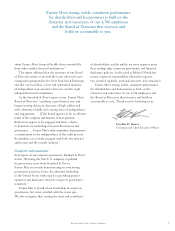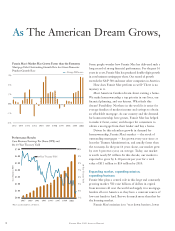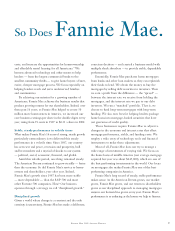Fannie Mae 2002 Annual Report Download - page 19
Download and view the complete annual report
Please find page 19 of the 2002 Fannie Mae annual report below. You can navigate through the pages in the report by either clicking on the pages listed below, or by using the keyword search tool below to find specific information within the annual report.
FANNIE MAE 2002 ANNUAL REPORT 17
immigration, which is expected to
create 13-15 million new households.
Already our market has grown
by over 10 percent in 2001 and over
12 percent in 2002. If our market
grows as expected throughout the
decade, it will more than double in
size, going from $5.6 trillion in 2000
to $11-$14 trillion by 2010. So you
see, if Fannie Mae merely grew at the
pace of our market, we could grow by
8-10 percent per year for the rest of
the decade — a rate that is faster than
GDP growth, and thus faster than
most of the S&P 500.
But we have grown faster than
our market for many years, largely
because we specialize in the most
popular mortgage in the fastest-
growing segment of our market, the
long-term, fixed-rate mortgage.
By the way, as big as Fannie Mae
is, our share of the market is relatively
small. We own only 11 percent
of mortgages in the market, and
guarantee the credit on another 15
percent. That gives us plenty of room
to grow within our growing market.
Now, given that we are a financial
company, some people think
Fannie Mae’s growth potential goes
up and down, driven by market cycles.
That’s not the case.
For instance, some believe
Fannie Mae’s growth is based on the
level of mortgage originations —
the number of home purchase and
refinancing loans that lenders make
with borrowers. Origination levels
can change with ups and downs in
the economy and interest rates. But
Fannie Mae’s growth is not tied to
the ups and downs in originations.
We don’t originate mortgages —
lenders do. We help to manage
the stock of outstanding mortgages
that lenders have originated.
So originations affect us to the extent
they increase the stock of mortgage
debt outstanding. That is why,
over the past 16 years, as mortgage
originations have gone up and down,
we’ve still grown each year.
Some also say Fannie Mae’s growth
is determined by interest rates. But
we deliberately manage our business
to minimize the impact of changing
interest rates. For example, when we
purchase long-term mortgages
from lenders, we generally fund the
purchase by selling long-term debt
securities, and we add options to the
securities that allow us to adjust the
term if interest rates move. That way,
we can maintain a relative match
between the interest rate we receive
from holding the mortgage, and the
interest rate we pay the investor for
funding the mortgage. In fact, over
the past 16 years, interest rates have
gone up and down and we’ve still
grown.
Finally, some believe our growth
is driven by the health of the economy.
But in fact, because of our underwriting
precision, geographic distribution,
equity in the home, and use of credit
enhancements, mortgage delinquencies
have gone up and down over the past
16 years and we’ve still grown.
The important thing to remember
is that Fannie Mae can keep growing
— in all business cycles and economic
conditions — because our market
keeps growing.
























